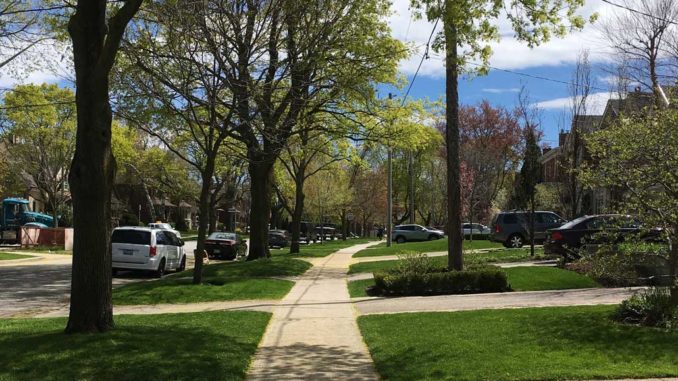
Depending on whom you talk to, riding a bike on the sidewalk is either a necessary safety measure or an unpredictable threat to those who walk. In reality it’s both. People who bike often revert to the sidewalk when conditions on the road appear hazardous, either because of the amount and speed of traffic, or roadwork. But on Toronto’s already narrow sidewalks, a cyclist weaving around pedestrians can feel like an unsafe intrusion to those on foot. In late June, Ward 16 Councillor Denzil Minnan-Wong pushed the debate about sidewalk cycling to the forefront, with an amendment to the City’s Cycling Network Plan.
Councillor Minnan-Wong asked that “City Council direct the General Manager, Transportation Services to develop a pilot project to allow bike traffic on sidewalks, for example, where there is a high volume of car traffic and few pedestrians and report back by the fourth quarter of 2020 on the merits of allowing cyclists to ride on designated sidewalks.”
At first glance, this sounds like an easy and inexpensive way to expand cycling options without offering up any space on the road. With the absence of bike lanes on busy arterials such as Bayview Ave., Leslie St. and Don Mills Rd., you already find people riding bikes on the sidewalk because they feel safer there. But City Council, in a 22 to 4 vote, deleted this amendment from the Cycling Network Plan.
Walk Toronto, the advocacy group for pedestrian safety, opposed the amendment, seeing it as increasing conflict between cyclists and pedestrians. In their submission they note, “From the safety perspective, investing in protected cycling infrastructure will achieve higher safety levels (for both cyclists and pedestrians).” Others saw liberalizing sidewalk cycling as a way for the City to get out of building proper bike lanes where cyclists and other wheeled users could get from A to B safely. Some questioned whether riding on sidewalks is actually safer, noting that drivers may not anticipate cyclists there when exiting driveways or approaching intersections. Questions were also raised about which sidewalks would be designated for cycling and how to deal with conflict zones such as transit stops and intersections – questions that a pilot might have answered.
The battle for cycling infrastructure in Toronto is almost always about available space, so it’s worth asking whether those underused sidewalks, which offer up considerable real estate beside arterials, could be repurposed as multi-use paths, widened to the City of Toronto’s default standard of 3.6 metres and protected from the roadway, providing a shared, safe space for people on bikes and on foot. It won’t be cheap and it’s not legalized sidewalk cycling, but it could be a way of bringing better and more attractive mobility options to the suburbs.
See Events Listings for the latest Ward 15 and 16 Cycling News.
Share the Sidewalk
Riding a bike on the sidewalk is illegal in Toronto for anyone age 14 and older. If you must use the sidewalk for safety concerns…
• Walk your bike when the sidewalk is busy or too narrow.
• Always yield to pedestrians, taking extra care around seniors, children and people with dogs.
• Go slowly and ring your bell to let others know you are approaching.


